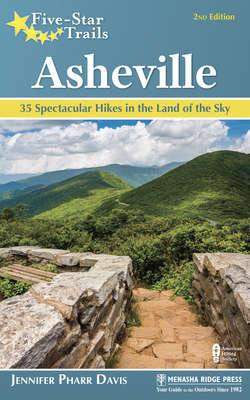Читать книгу Five-Star Trails: Asheville - Jennifer Pharr Davis - Страница 10
На сайте Литреса книга снята с продажи.
ОглавлениеPreface
WELCOME TO THE SECOND EDITION of this hiking guide to greater Asheville. If you love to hike, there is arguably no better place to enjoy the great outdoors than Asheville, North Carolina. I grew up in these mountains and spent many childhood hours outside with my parents and brothers on local trails. I remember thinking, when I was young, that the “talking” trees at Holmes Educational State Forest really spoke to me; that Mount Pisgah was possibly the tallest, most difficult mountain in the world; and that the coldest water on earth was found at Sliding Rock.
I never appreciated what a big part of my life these mountains and trails had become until I moved away from the region. Immediately, I began to miss the Southern Appalachians, and soon I realized that these ancient mountains were calling me home. These peaks offer more than just a pretty view or a place to exercise. These mountains are wise overseers who mark the passing of time with delicate springtime buds, the consuming green of summertime, a canopy of fall colors, and a naked vulnerability in winter.
After hiking in many other parts of the United States and on other continents, I often hear people comment that the Southern Appalachians are not as stunning or dramatic as other mountainous areas. I disagree. The highlands around Asheville are some of the oldest and most biodiverse in the world. There may not be a breathtaking mountain vista around every corner, but the intricacies found within the forest shelter can keep a child occupied for hours. It is as if the Appalachians hold their secrets a little closer, and reveal them to those who are willing to take the time to explore the terrain.
The challenge for hiking within the Blue Ridge is often much greater than that found in higher mountains. There are more roots, rocks, and texture on the trails near Asheville than on the paths in the proximity of other mountain towns. And despite millions of years of erosion wearing down these surrounding mountains, Western North Carolina can still claim Mount Mitchell, the highest mountain east of the Mississippi River.
The region boasts multiple long-distance trails. They include, of course, the Appalachian Trail—the most famous footpath in the world, and also the Mountains-to-Sea Trail. The latter connects the Great Smoky Mountains with the white sand dunes at the eastern end of the state. Near Asheville, the Mountains-to-Sea Trail parallels the ever-popular Blue Ridge Parkway. That national scenic road provides a direct gateway to nature for many of the residents of Asheville and the surrounding areas.
I chose the hikes in this book to showcase the highlights in and around Asheville. I made every attempt to combine the well-known favorites of the region with those less-traveled—but comparably scenic—routes, creating a montage of outdoor experiences for you to indulge in. Although the hiking in this region is not considered easy when compared with the rest of the southeastern United States, the guidebook covers hikes with a wide array of distances, terrains, and difficulties to suit all ages and skill levels. Many of the trail descriptions include suggestions for extending or shortening the prescribed route, providing even more choices.
Still, the most daunting challenge of writing this guidebook was narrowing the hundreds of excursions down to 35 of the best day hikes. The Asheville area offers myriad choices that rank high, apropos of the publisher’s Five-Star Trails series categories. As you hike the trails that I’ve selected, I am sure you will discover more of your own favorites.
